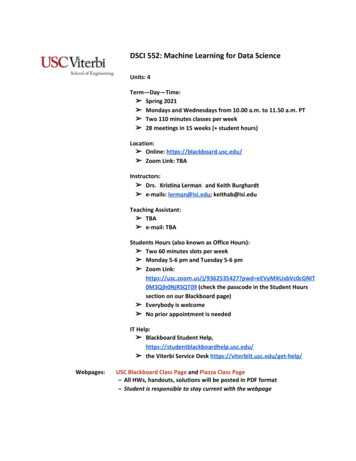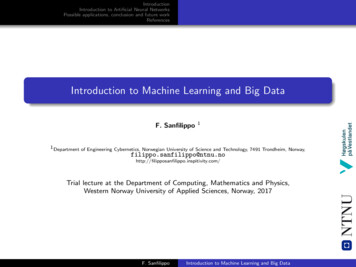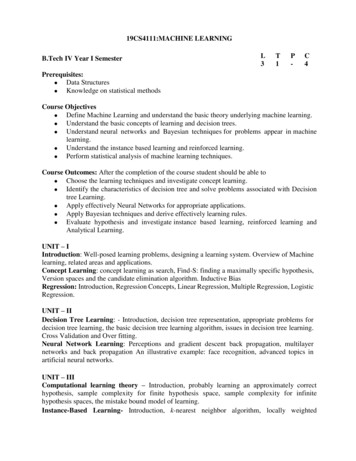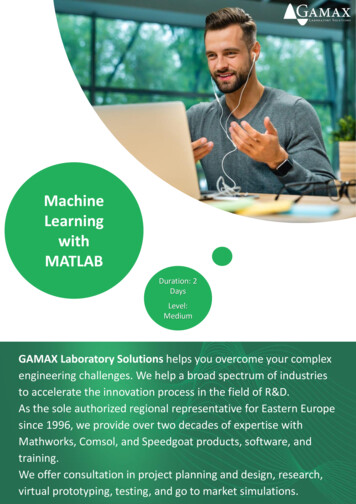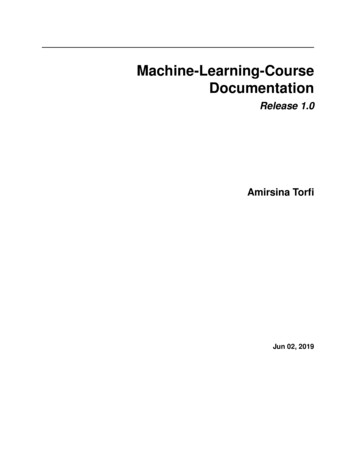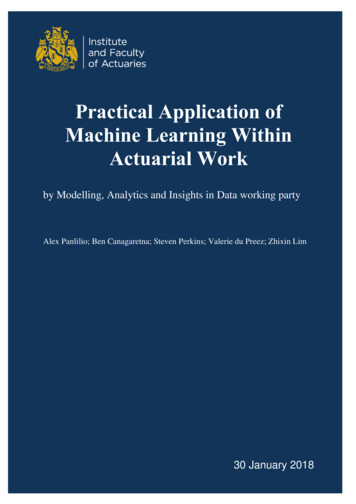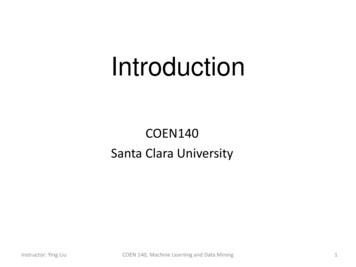
Transcription
IntroductionCOEN140Santa Clara UniversityInstructor: Ying LiuCOEN 140, Machine Learning and Data Mining1
COEN140 Course Information Instructor: Dr. Ying Liu, email: yliu15@scu.eduHomepage: http://www.cse.scu.edu/ yliu1/Office Hours: Thursday, 10:30AM - 11:30AM, Online,or by appointment TA: Xuyang Wu, email: xwu5@scu.edu Lectures: Monday, Wednesday, Friday,10:30AM - 11:35AM, Online Labs: COEN140L-01 Wednesday, 2:15PM - 5:00PM, OnlineCOEN140L-02 Thursday, 2:15PM - 5:00PM, OnlineInstructor: Ying LiuCOEN 140, Machine Learning and Data Mining2
References “Hands-On Machine Learning with Scikit-Learn andTensorFlow: Concepts, Tools, and Techniques to BuildIntelligent Systems”, 1st Edition, by Aurélien Géron,ISBN-13: 978-1491962299, ISBN-10: 1491962291. “Pattern Recognition and Machine Learning”, 1stEdition, by Christopher M. Bishop, Springer, 2006.ISBN-13: 978-0387310732. “Learning Python”, 5th Edition, by Mark Lutz, O’ReillyMedia, Inc., 2013. ISBN: 978-1-449-35573-9.Instructor: Ying LiuCOEN 140, Machine Learning and Data Mining3
References Pattern Classification, 2nd Edition, by R. O. Duda, P. E.Hart, and D. G. Stork, Wiley 2001. ISBN-13: 9780471056690 Machine Learning: A Probabilistic Perspective, byKevin P. Murphy, The MIT Press, 2012. ISBN-13: 9780262018029. Website: http://cs231n.stanford.edu/Instructor: Ying LiuCOEN 140, Machine Learning and Data Mining4
GradingLecture and Lab sessions will be given thesame letter gradePercentage(100%)Homework AssignmentsLab Assignments (python programming)Midterm ExamFinal Exam20%20%25%35%Instructor: Ying LiuCOEN 140, Machine Learning and Data Mining5
Homework and Lab Assignments Strict deadline! 20% deducted per day late, for each assignmentsubmission(i.e. if 5 days late, 0 score) Excuses such as technical issue (e.g. Internet access orfile corruption) won’t be accepted. Because this isunfair to other students who submit the assignmentson time. Double check the files when you submitthem. Do not wait till the last minute!Instructor: Ying LiuCOEN 140, Machine Learning and Data Mining6
Homework and Lab Assignments You are encouraged to discuss the assignments withclassmates. However, you must independently writeup your own solutions and implement your owncode. Very similar assignment submissions will beconsidered as academic dishonesty. Make-up exams will not be given except forlegitimate reasons with supporting documentation(for example, a medical reason with doctor’s officialnote), and with prior approval from the instructorInstructor: Ying LiuCOEN 140, Machine Learning and Data Mining7
Schedule (subject to change) Week 1: Introduction, Linear Algebra Review.Week 2: Regression.Week 3: Gradient Descent, Clustering.Week 4: Logistic Regression.Week 5: Neural Network.Week 6: Deep Learning.Week 7: Maximum Likelihood Estimator, BayesianClassifier. Week 8: Decision Trees. Week 9: Principal-Component Analysis, LinearDiscriminant Analysis. Week 10: Review.Instructor: Ying LiuCOEN 140, Machine Learning and Data Mining8
What is Machine Learning? Spam Filter Example What is a spam filter?Instructor: Ying LiuCOEN 140, Machine Learning and Data Mining9
What is Machine Learning? How would you develop a spam filter? Develop a computer programInstructor: Ying LiuCOEN 140, Machine Learning and Data Mining10
Spam Filter How would you develop a spam filter? Look at what spam typically looks like Words that appear in the subject Patterns in the sender’s name, the email’s body, etc.Instructor: Ying LiuCOEN 140, Machine Learning and Data Mining11
ing an email message as spam or not-spam). Since “not-spam” is awkward, researchecoinedSpamthe termFilterham for not-spam. We can treat spam detection as a problem in suplearning. A training set is readily available: the positive (spam) examples are in mAnnegativeexcerptfolder, the(ham) examples are in my inbox. Here is an excerpt:Spam: Wholesale Fashion Watches -57% today. Designer watches for cheap .Spam: You can buy ViagraFr 1.85 All Medications at unbeatable prices! .Spam: WE CAN TREAT ANYTHING YOU SUFFER FROM JUST TRUST US .Spam: Sta.rt earn*ing the salary yo,u d-eserve by o’btaining the prope,r crede’ntials!Ham:Ham:Ham:Ham:The practical significance of hypertree width in identifying more .Abstract: We will motivate the problem of social identity clustering: .Good to see you my friend. Hey Peter, It was good to hear from you. .PDS implies convexity of the resulting optimization problem (Kernel Ridge .From thisexcerptwe can startget an ideaspam?of what might be good features to incGoodfeaturesthattoindicatethe supervised learning model. Word n-grams such as “for cheap” and “You can buy Words: “for cheap”, “You can buy”: indicators ofto be indicators of spam (although they would have a nonzero probability in ham asspamCharacter-level features also seem important: spam is more likely to be all uppercasehave punctuation embedded in words. Apparently the spammers thought that the word“you deserve” would be too indicative of spam, and thus wrote “yo,u d-eserve” instInstructor: Ying LiuCOEN 140, Machine Learning and Data Mining12character model should detect this. We could either create a full character n-gram
ing an email message as spam or not-spam). Since “not-spam” is awkward, researchecoinedSpamthe termFilterham for not-spam. We can treat spam detection as a problem in suplearning. A training set is readily available: the positive (spam) examples are in mAnnegativeexcerptfolder, the(ham) examples are in my inbox. Here is an excerpt:Spam: Wholesale Fashion Watches -57% today. Designer watches for cheap .Spam: You can buy ViagraFr 1.85 All Medications at unbeatable prices! .Spam: WE CAN TREAT ANYTHING YOU SUFFER FROM JUST TRUST US .Spam: Sta.rt earn*ing the salary yo,u d-eserve by o’btaining the prope,r crede’ntials!Ham:Ham:Ham:Ham:The practical significance of hypertree width in identifying more .Abstract: We will motivate the problem of social identity clustering: .Good to see you my friend. Hey Peter, It was good to hear from you. .PDS implies convexity of the resulting optimization problem (Kernel Ridge .From thisexcerptwe can startget an ideaspam?of what might be good features to incGoodfeaturesthattoindicatethe supervised learning model. Word n-grams such as “for cheap” and “You can buy be all uppercase, orto be indicators of spam (although they would have a nonzero probability in ham as havepunctuationembeddedCharacter-levelfeaturesalso seem important:spaminiswordsmore likely to be all uppercasehave punctuationembeddedin words.Apparentlythe spammers thought that the word“youdeserve”- “yo,ud-eserve”“you deserve” would be too indicative of spam, and thus wrote “yo,u d-eserve” instInstructor: Ying LiuCOEN 140, Machine Learning and Data Mining13character model should detect this. We could either create a full character n-gram
Spam Filter Write a detection algorithm for each of theseabnormal patterns. Your program will flag emails asspam if a number of these patterns are detected. You would test your program Let your program take a new email Your program will check whether the input email hasthose abnormal patterns Your program will output the final decisionInstructor: Ying LiuCOEN 140, Machine Learning and Data Mining14
Spam Filter How to evaluate whether your program is good ornot? Assume: you have 1000 new emails, which you knowthe “ground-truth” You test your program with these 1000 emails Collect detection errors If the error rate is high, then your program is bad Go back to modify those abnormal patterns Instructor: Ying LiuCOEN 140, Machine Learning and Data Mining15
Traditional Programming Traditional Programming of a Spam Filter Rules: hand-tunedInstructor: Ying LiuCOEN 140, Machine Learning and Data Mining16
Traditional Programming Drawback The problem is nontrivial, your program will likelybecome a long list of complex rules – hard tomaintain.Instructor: Ying LiuCOEN 140, Machine Learning and Data Mining17
A spam filter based on Machine Learning Rules: automatically generatedInstructor: Ying LiuCOEN 140, Machine Learning and Data Mining18
A spam filter based on Machine Learning Automatically learns which words are good predictorsof spam The program is much shorter Easier to maintain Most likely more accurateInstructor: Ying LiuCOEN 140, Machine Learning and Data Mining19
Motivation of Machine Learning Existing solutions for many problems Require a lot of hand-tuning or long lists of rules Machine Learning can often simplify code andperform betterInstructor: Ying LiuCOEN 140, Machine Learning and Data Mining20
Motivation of Machine Learning Machine Learning can Automatically discover patterns/regularities in data Use these regularities to take actions for new data Adapt to environment change and new data Get insights about complex problems and largeamounts of dataInstructor: Ying LiuCOEN 140, Machine Learning and Data Mining21
Elements of Machine Learning Data (Training Data) Experience e.g. 10000 emails, some are spam, some are ham Task Classification Prediction Algorithm (computer program) Automatically generate “rules” to do the task Performance Evaluation Metric e.g. detection error rateInstructor: Ying LiuCOEN 140, Machine Learning and Data Mining22
Elements of Machine Learning An algorithm (computer program) is considered as aMachine Learning algorithm (program) if Its performance on the task, as measured by theevaluation metric, improves with experience (data).Instructor: Ying LiuCOEN 140, Machine Learning and Data Mining23
Applications of Machine Learning Recognition Face, speech, handwritten character Fraud detection (e.g., abnormal credit cardtransactions) Recommender systems (e.g., which movies/productsyou would like) Market prediction (e.g., stock/house prices) Defense applications: military attack detection Decision Making: RoboticsInstructor: Ying LiuCOEN 140, Machine Learning and Data Mining24
Supervised vs Unsupervised Learning Supervised Learning: explicit feedback in the form oftarget values Goal: to make predictions (predict prices), or togenerate class labels Target values: the true price values, or the true classlabels (call them the ground-truths) Unsupervised learning: only samples, no target values Goal: to reveal structure in the observed dataInstructor: Ying LiuCOEN 140, Machine Learning and Data Mining25
Supervised Learning: Classification The goal is to assign each input to one of a finitenumber of discrete categories Face recognitionHand-written digit recognitionSpeech recognitionMedical diagnosis from symptoms to illnesses Web Advertising predict if a user will click on an ad on the InternetInstructor: Ying LiuCOEN 140, Machine Learning and Data Mining26
Classification You want to classifyversus Training Data: 100 monkey images and 200 human images withlabels what is what.𝐱 𝑖 , 𝑡𝑖 0 , 𝑖 1, , 100𝐱𝑗 , 𝑡𝑗 1 , 𝑗 1, , 200 where 𝐱 represents the intensity of the image pixels and𝑡 0 means “monkey” while 𝑡 1 means “human”. (Training) Samples: 𝐱 Target values: labels 𝑡 The ground-truth valuesInstructor: Ying LiuCOEN 140, Machine Learning and Data Mining27
Classification You want to classifyversus Task: Here is a new image:human?monkey or Challenges lighting, pose , expressions, occlusions (glasses, beard),make-up, hair styleInstructor: Ying LiuCOEN 140, Machine Learning and Data Mining28
Classification Hand-written Digits RecognitionEach digit: a 28x28 pixel imageRepresented by a vector 𝐱: 784 real numbersGoal: build a machine that will take 𝐱 as input andproduce the identity of the digit 0, , 9 as the output Samples: vectorized images 𝐱 Target values (labels): 0, 1, 2, , 9Instructor: Ying LiuCOEN 140, Machine Learning and Data Mining29
Classification Hand-written Digits Recognition Challenges Different hand-writing stylesInstructor: Ying LiuCOEN 140, Machine Learning and Data Mining30
Classification Skin Detection ProblemTesting Stage Sample? Target value?Instructor: Ying LiuCOEN 140, Machine Learning and Data Mining31
Classification: Face Recognition SystemAssume:Original imagedimension: 𝐷After featureextraction: 𝑑𝑑 𝐷Instructor: Ying LiuCOEN 140, Machine Learning and Data Mining32
Supervised Learning: Regression When the desired output (target value) consists ofone or more continuous values Temperature prediction Price prediction .Instructor: Ying LiuCOEN 140, Machine Learning and Data Mining33
Regression Predict the price of a used car 𝑥: car mileage 𝑡: target price(red dots values) 𝑦: predicted price(blue line values)Instructor: Ying Liuy 𝑓 𝑥, 𝑤0 , 𝑤1 𝑤0 𝑤1 𝑥COEN 140, Machine Learning and Data Mining34
Regression Predict the price of a used car Model: 𝑓(𝑥, 𝑤0 , 𝑤1 ) (model) Parameters:𝑤0 , 𝑤1 To learn a model thatgenerates 𝑦 close to 𝑡Instructor: Ying Liuy 𝑓 𝑥, 𝑤0 , 𝑤1 𝑤0 𝑤1 𝑥COEN 140, Machine Learning and Data Mining35
Regression We are given 𝑁 10 samples (data points)𝑥1 , 𝑥2, , 𝑥𝑁 Observations of the target values𝑡1 , 𝑡2, , 𝑡𝑁 Green sine curve: the underlying data generationmechanismInstructor: Ying LiuCOEN 140, Machine Learning and Data Mining36
Regression We are given 𝑁 10 samples (data points)𝑥1 , 𝑥2, , 𝑥𝑁 Observations of the target values𝑡1 , 𝑡2, , 𝑡𝑁 Blue circles: data points (noisy)Instructor: Ying LiuCOEN 140, Machine Learning and Data Mining37
Regression We are given 𝑁 10 samples (data points)𝑥1 , 𝑥2, , 𝑥𝑁 Observations of the target values𝑡1 , 𝑡2, , 𝑡𝑁 Red curve: the curve learned from these samplesInstructor: Ying LiuCOEN 140, Machine Learning and Data Mining38
Unsupervised Learning The training data consists of a set of samples withoutany corresponding target values Goal: to reveal structure in the observed dataInstructor: Ying LiuCOEN 140, Machine Learning and Data Mining39
Unsupervised Learning Clustering: to discover groups of similar sampleswithin the dataInstructor: Ying LiuCOEN 140, Machine Learning and Data Mining40
Unsupervised Learning Dimensionality Reduction: project the data from ahigh-dimensional space down to a low-dimensionalspace Discard unimportant features For visualization e.g. The Swiss RollInstructor: Ying LiuCOEN 140, Machine Learning and Data Mining41
Unsupervised Learning Anomaly detection: detect unusual instances Anomalous Internet traffic flowInstructor: Ying LiuCOEN 140, Machine Learning and Data Mining42
Batch Learning vs Online Learning Batch Learning: the system is trained using theavailable training data all at once a.k.a. Offline learning Take a lot of time and computing resources First the system is learned with all available data, andthen it is launched into production and runs withoutlearning anymoreInstructor: Ying LiuCOEN 140, Machine Learning and Data Mining43
Batch Learning vs Online Learning Online Learning: you train the system incrementallyby feeding it data samples sequentially, either one byone or by small groups of samples called mini-batchesInstructor: Ying LiuCOEN 140, Machine Learning and Data Mining44
Batch Learning vs Online Learning Online Learning: Each learning step is fast and cheap,so the system can learn about new data on the fly, asit arrives Good for systems that receive data as a continuousflow (e.g., stock prices) and need to adapt to changerapidly or autonomously Good if your system have limited storage space: oncean online learning system has learned from new datasamples, it does not need them anymore, so it candiscard themInstructor: Ying LiuCOEN 140, Machine Learning and Data Mining45
Model-Based Learning Learn a model of the training samples, then use thatmodel to make predictions Steps: You studied the data. You selected a model (a function that has someunknown parameters) You trained the model on the training data (i.e., thelearning algorithm searched for the modelparameter values that minimize a cost function).Instructor: Ying LiuCOEN 140, Machine Learning and Data Mining46
Model-Based Learning Learn a model of the training samples, then use thatmodel to make predictions Steps: Finally, you applied the model to make predictionson new samples (this is called inference), hoping thatthis model will generalize well.Instructor: Ying LiuCOEN 140, Machine Learning and Data Mining47
Model-Based Learning Example: you want to know if money makes peoplehappy, so you download the Life Satisfaction data aswell as stats about GDP per capita. Then you join thetables and sort by GDP per capita.Instructor: Ying LiuCOEN 140, Machine Learning and Data Mining48
Model-Based Learning Plot the data for a few random countriesInstructor: Ying LiuCOEN 140, Machine Learning and Data Mining49
Model-Based Learning Model selection: you selected a linear model of lifesatisfaction with just one attribute, GDP per capitaInstructor: Ying LiuCOEN 140, Machine Learning and Data Mining50
Model-Based Learning Train the model: you feed the model your trainingsamples and it finds the parameters that make thestraight-line fit best to your data.Instructor: Ying LiuCOEN 140, Machine Learning and Data Mining51
Training Set For machine learning, the training set is a set of datasamples that you will use to generate a machinelearning model Supervised Learning Training set: 𝑥𝑛 , 𝑡𝑛 , 𝑛 1, , 𝑁𝑡𝑟𝑎𝑖𝑛 𝑁𝑡𝑟𝑎𝑖𝑛 training samples 𝑥𝑛 is the input, 𝑡𝑛 is the target value In general, the input and the target value can both bemulti-dimensional 𝐱 𝑛 , 𝐭 𝑛 , 𝑛 1, , 𝑁Instructor: Ying LiuCOEN 140, Machine Learning and Data Mining52
Training Set For machine learning, the training set is a set of datasamples that you will use to generate a machinelearning model Supervised Learning Training set: 𝑥𝑛 , 𝑡𝑛 , 𝑛 1, , 𝑁𝑡𝑟𝑎𝑖𝑛 A function will be learned to map the input to thecorresponding output e.g. 𝑦𝑛 𝑓 𝑥𝑛 We want 𝑓( ) to be such that the model output 𝑦𝑛 is closeto the target output 𝑡𝑛Instructor: Ying LiuCOEN 140, Machine Learning and Data Mining53
Test Set The test set is a set of data samples that areindependent of the training set. Test set: 𝑥𝑛 , 𝑡𝑛 , 𝑛 1, , 𝑁𝑡𝑒𝑠𝑡or multi-dimensional: 𝐱 𝑛 , 𝐭 𝑛 , 𝑛 1, , 𝑁𝑡𝑒𝑠𝑡 You will use the test set to evaluate the performanceof the learned function/model 𝑓( ) Training Set and Test Set cannot overlap They cannot have common data samplesInstructor: Ying LiuCOEN 140, Machine Learning and Data Mining54
Challenges in ML: Due to Data Insufficient Quantity of Training Data Nonrepresentative Training Data e.g. missing important training samples Poor-Quality Data When the training data is contaminated by outliers,and noise (e.g., due to poor-quality measurements) Irrelevant Features Need feature selection/extractionInstructor: Ying LiuCOEN 140, Machine Learning and Data Mining55
Challenges in ML: Due to Algorithms Overfitting: the model performs well on the trainingdata, but it does not generalize well. It happens when the model is too complex relative tothe amount of the training data. Generalization Capability: whether your trainedmodel works well on new, unseen data samples Underfitting: when your model is too simple to learnthe underlying structure of the dataInstructor: Ying LiuCOEN 140, Machine Learning and Data Mining56
Instructor: Ying Liu COEN 140, Machine Learning and Data Mining 12 Se cti on 22.2. T ex t C l assi ¿F ati on 865 much better. T he model s ag ree wi th thi s assessment: the perpl ex i ty was 891 f or the uni g ram model , 142 f or the bi g ram model and 91 for the tri g ram model . Wi th the basi cs of n r am mKrr- d rdHd , we can rn now to .



